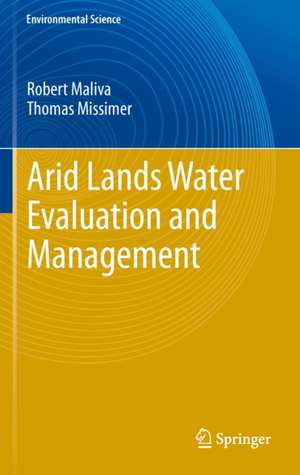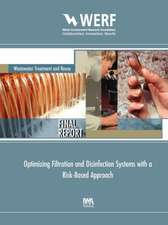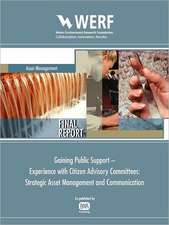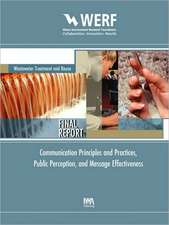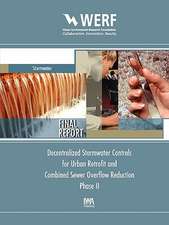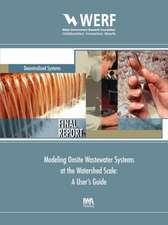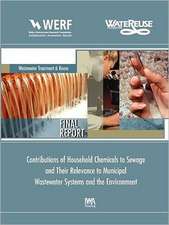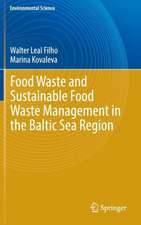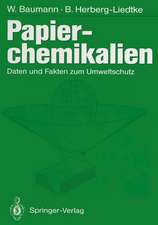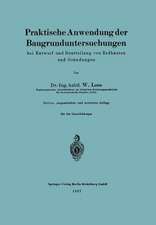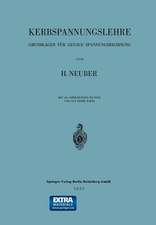Arid Lands Water Evaluation and Management: Environmental Science and Engineering
Autor Robert Maliva, Thomas Missimeren Limba Engleză Hardback – 10 iun 2012
| Toate formatele și edițiile | Preț | Express |
|---|---|---|
| Paperback (1) | 1254.98 lei 6-8 săpt. | |
| Springer Berlin, Heidelberg – 23 aug 2016 | 1254.98 lei 6-8 săpt. | |
| Hardback (1) | 1259.90 lei 6-8 săpt. | |
| Springer Berlin, Heidelberg – 10 iun 2012 | 1259.90 lei 6-8 săpt. |
Din seria Environmental Science and Engineering
- 18%
 Preț: 1238.42 lei
Preț: 1238.42 lei - 18%
 Preț: 2166.68 lei
Preț: 2166.68 lei - 18%
 Preț: 1420.88 lei
Preț: 1420.88 lei - 18%
 Preț: 914.20 lei
Preț: 914.20 lei - 18%
 Preț: 1225.94 lei
Preț: 1225.94 lei - 18%
 Preț: 1118.13 lei
Preț: 1118.13 lei - 18%
 Preț: 1402.74 lei
Preț: 1402.74 lei - 18%
 Preț: 3419.93 lei
Preț: 3419.93 lei - 18%
 Preț: 1223.55 lei
Preț: 1223.55 lei - 18%
 Preț: 1008.91 lei
Preț: 1008.91 lei - 18%
 Preț: 1234.46 lei
Preț: 1234.46 lei - 18%
 Preț: 1409.82 lei
Preț: 1409.82 lei - 18%
 Preț: 736.64 lei
Preț: 736.64 lei - 18%
 Preț: 949.73 lei
Preț: 949.73 lei - 18%
 Preț: 1287.47 lei
Preț: 1287.47 lei - 18%
 Preț: 2116.64 lei
Preț: 2116.64 lei - 18%
 Preț: 1231.95 lei
Preț: 1231.95 lei - 15%
 Preț: 641.71 lei
Preț: 641.71 lei - 23%
 Preț: 1129.31 lei
Preț: 1129.31 lei - 18%
 Preț: 1237.93 lei
Preț: 1237.93 lei - 18%
 Preț: 956.18 lei
Preț: 956.18 lei - 24%
 Preț: 1057.93 lei
Preț: 1057.93 lei - 24%
 Preț: 1079.06 lei
Preț: 1079.06 lei - 18%
 Preț: 953.03 lei
Preț: 953.03 lei - 18%
 Preț: 1233.06 lei
Preț: 1233.06 lei - 15%
 Preț: 666.73 lei
Preț: 666.73 lei - 18%
 Preț: 1222.31 lei
Preț: 1222.31 lei - 18%
 Preț: 1242.35 lei
Preț: 1242.35 lei - 18%
 Preț: 1232.89 lei
Preț: 1232.89 lei - 18%
 Preț: 1823.56 lei
Preț: 1823.56 lei - 18%
 Preț: 1228.96 lei
Preț: 1228.96 lei - 18%
 Preț: 1221.69 lei
Preț: 1221.69 lei - 18%
 Preț: 945.79 lei
Preț: 945.79 lei - 18%
 Preț: 1008.28 lei
Preț: 1008.28 lei - 24%
 Preț: 795.49 lei
Preț: 795.49 lei - 18%
 Preț: 1246.47 lei
Preț: 1246.47 lei - 18%
 Preț: 1239.85 lei
Preț: 1239.85 lei - 18%
 Preț: 957.62 lei
Preț: 957.62 lei - 18%
 Preț: 1244.89 lei
Preț: 1244.89 lei - 15%
 Preț: 640.55 lei
Preț: 640.55 lei - 18%
 Preț: 950.33 lei
Preț: 950.33 lei - 18%
 Preț: 1824.01 lei
Preț: 1824.01 lei - 15%
 Preț: 639.59 lei
Preț: 639.59 lei - 18%
 Preț: 947.50 lei
Preț: 947.50 lei - 18%
 Preț: 951.29 lei
Preț: 951.29 lei - 18%
 Preț: 1229.73 lei
Preț: 1229.73 lei
Preț: 1259.90 lei
Preț vechi: 1536.45 lei
-18% Nou
Puncte Express: 1890
Preț estimativ în valută:
241.14€ • 250.80$ • 202.08£
241.14€ • 250.80$ • 202.08£
Carte tipărită la comandă
Livrare economică 14-28 martie
Preluare comenzi: 021 569.72.76
Specificații
ISBN-13: 9783642291036
ISBN-10: 3642291031
Pagini: 774
Ilustrații: XXIX, 1076 p.
Dimensiuni: 155 x 235 x 61 mm
Greutate: 1.66 kg
Ediția:2012
Editura: Springer Berlin, Heidelberg
Colecția Springer
Seriile Environmental Science and Engineering, Environmental Science
Locul publicării:Berlin, Heidelberg, Germany
ISBN-10: 3642291031
Pagini: 774
Ilustrații: XXIX, 1076 p.
Dimensiuni: 155 x 235 x 61 mm
Greutate: 1.66 kg
Ediția:2012
Editura: Springer Berlin, Heidelberg
Colecția Springer
Seriile Environmental Science and Engineering, Environmental Science
Locul publicării:Berlin, Heidelberg, Germany
Public țintă
ResearchCuprins
From the Contents: Aridity and Drought.- Geology of Arid Lands.- Aquifer Concepts in Arid Lands.- Introduction to Aquifer Hydraulics.- Water Budget.- Precipitation and Evapotranspiration.- Recharge Concepts and Settings.- Sustainability and Safe Yield.- Assessment of Groundwater Resources.- Recharge Measurement in Arid and Semiarid Regions.- Environmental Isotopes.- Wadi Recharge Evaluation.- Microgravity.- Compaction and Land Subsidence.- Surface and Airborne Geophysics.- Borehole Geophysical Techniques.- Remote Sensing.- Geographic Information Systems.- Groundwater Flow and Solute-Transport Modeling.- Ancient Water Management.- Rainwater, Stormwater, and Fog Harvesting.- Managed Aquifer Recharge.
Recenzii
From the reviews:
“This book focuses on the technologies available to assess, manage, and develop water resources in arid regions worldwide. … The book highlights the problems with past management methods and offers new solutions that take a holistic approach by recognizing and considering economic, sociocultural, and political issues. … the authors address current and best practices in easy-to-understand language. Summing Up: Highly recommended. Upper-division undergraduate through graduate students in environmental sciences/economics, engineering, or hydrogeology; researchers/faculty; professionals/practitioners; government officials in arid regions worldwide.” (M. E. Lenczewski, Choice, Vol. 50 (8), April, 2013)
“This book focuses on the technologies available to assess, manage, and develop water resources in arid regions worldwide. … The book highlights the problems with past management methods and offers new solutions that take a holistic approach by recognizing and considering economic, sociocultural, and political issues. … the authors address current and best practices in easy-to-understand language. Summing Up: Highly recommended. Upper-division undergraduate through graduate students in environmental sciences/economics, engineering, or hydrogeology; researchers/faculty; professionals/practitioners; government officials in arid regions worldwide.” (M. E. Lenczewski, Choice, Vol. 50 (8), April, 2013)
Textul de pe ultima copertă
A large part of the global population lives in arid lands which have low rainfall and often lack the water required for sustainable population and economic growth. This book presents a comprehensive description of the hydrogeology and hydrologic processes at work in arid lands. It describes the techniques that can be used to assess and manage the water resources of these areas with an emphasis on groundwater resources, including recent advances in hydrologic evaluation and the differences between how aquifer systems behave in arid lands versus more humid areas. Water management techniques are described and summarized to show how a more comprehensive approach to water management is required in these areas, including the need to be aware of cultural sensitivities and conditions unique to many arid regions. The integration of existing resources with the addition of new water sources, such as desalination of brackish water and seawater, along with reusing treated wastewater, will be required to meet future water supply needs. Also, changing climatic conditions will force water management systems to be more robust so that future water supply demands can be met as droughts become more intense and rainfall events become more intense. A range of water management techniques are described and discussed in order to illustrate the methods for integrating these measures within the context of arid lands conditions.
Caracteristici
Constitutes the first comprehensive book on arid lands water management that includes all aspects of the water supply, including groundwater, surface water, desalination, and water reuse Richly illustrated with over 10 color illustrations showing many photographs of geologic and hydrologic features unique to arid lands Integrates water management techniques with the science of aquifer hydrogeology and other engineering aspects of water supply Includes supplementary material: sn.pub/extras
